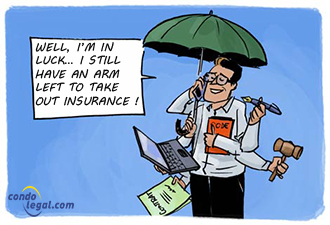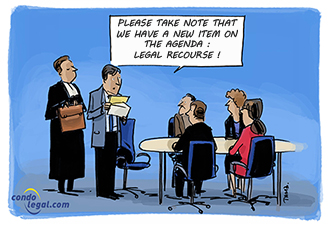19 Articles

With the increasing presence of tenants in divided co-ownership buildings, it is essential for all stakeholders to fully understand the issues related to insurance coverage. Unlike in other countries, Quebec law does not require tenants to purchase “home insurance”, which would cover their belongings and civil liability in the event of a loss. This lack of obligation can pose a problem if a tenant causes damage and is not insured. In such a situation, the…...

As a co-owner, you may face a multitude of risks for which it is in your best interest to be insured. You have the legal obligation, just like the syndicate of co-owners, to take out at least liability insurance, which covers unintentional damage caused to others. In addition to this mandatory coverage, it is recommended to take out supplementary insurance. For example, the insurance covering improvements made to a private portion protects the additions made…...

The tasks of the condo manager are numerous. The latter may be mandated to manage the immovable, and thus ensure its preservation and maintenance; implement the decisions of the board of directors; settle major losses, take out the insurance required for your syndicate, but also to enforce the by-laws of the immovable. Therefore, his civil liability may be invoked. If he is at fault, he is exposed to recourses or claims for compensation, whether by…...

A co-ownership may face a multitude of risks such as fires, water damages, break-ins and acts of vandalism. In the event of a loss, the co-ownership's insurance plays an essential role in ensuring its sustainability and so, by covering not only the immovable itself but also the civil liability of the syndicate of co-owners. It is imperative for any syndicate to conclude a suitable insurance, a requirement stated in the Civil Code of Québec and reiterated by the majority…...

Claims in co-ownerships are numerous: water leaks, water damages, vandalism, fire, etc. If the claim affects both the common portions and private portions of the co-ownership, it is the responsibility of the board of directors to handle the notice of loss with the syndicate's insurer and to arrange for its repair. Effective management of a claim requires prompt and efficient actions to ensure that your building is repaired or rebuilt as quickly as possible. Here…...

The day-to-day administration of the co-ownership may be entrusted to a co-ownership manager who may or not be chosen from the co-owners; thus, the syndicate can delegate to the co-ownership manager other tasks and responsibilities that are generally handled by the board of directors such as the collection of claims, the publication of a notice regarding a legal hypothec on the fraction of the defaulting co-owner as well as to institute legal proceedings for all matters concerning its administration. In brief, the task management of the co-ownership…...

The appointment of meeting officers is necessary to hold a meeting of co-owners. The titles that can be occupied by the meeting officers are as follows: president, vice-president, secretary and scrutineer; although the functions of each of these roles are distinct, their purpose is to ensure that the debates are properly conducted and that they are transcribed in the minutes in order to record the decisions that were taken. The by-laws of the immovable (second part of the declaration of co-ownership)…...

The director plays a leading role in a co-ownership; as a mandatary of the syndicate of co-owners, he ensures the smooth running of the immovable’s day to day business which implies a working knowledge of the tasks related to this function. As such, directors must act with prudence, diligence, honesty and loyalty because they evolve in a legal environment where their civil liability can be sought as part of their mandate on behalf of the co-ownership as well as towards third party…...

Whether semi-detached or row, the townhouse is a good compromise between the typical co-ownership apartment and the single-family home. This type of project is established in "horizontal co-ownership". Each of the fractions is composed of a private portion (usually a house) and a share of common portions (the land). Each co-owner is the owner of his private portion "from nadir to zenith", while the common portions are usually limited to traffic lanes, parking lots and certain…...
